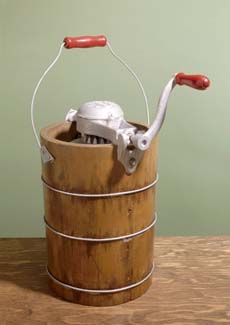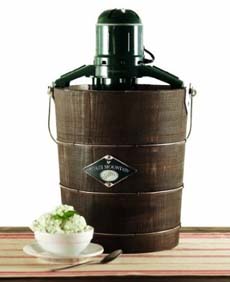|

 History has not recorded much information on Nancy M. Johnson, who invented the hand-cranked ice cream freezer. We owe her a great debt. The freezer in the photo is a later model White Mountain, circa 1923-1930. Photo courtesy ScienceMuseum.org.uk. History has not recorded much information on Nancy M. Johnson, who invented the hand-cranked ice cream freezer. We owe her a great debt. The freezer in the photo is a later model White Mountain, circa 1923-1930. Photo courtesy ScienceMuseum.org.uk.
July 2006
Last Updated April 2013
|
 |
The History of The Ice Cream Maker
Page 3: The Ice Cream Freezer
This is Page 3 of an eight-page article on the history of ice cream. Click on the black links below to visit other pages.
1851: American Ingenuity Invents The Ice Cream Freezer
- Until 1800, ice cream remained a rare and exotic dessert enjoyed mostly by the elite. As with most foodstuffs, by the 19th century, ingredients and technology, including the development of ice harvesting and the invention of the insulated icehouse (around 1800), had evolved to give the public affordable access. Sugar became more affordable. But it took two other milestones to make ice cream an “industry.”
- In 1843, New Yorker Nancy M. Johnson applied for a patent for the hand-cranked ice cream freezer, with a movable crank and a center paddle to churn the mix around. After turning the crank for 45 minutes or so (much less labor than stirring with a spoon), the delicious treat emerged. The machine sold quickly, and within a short period of time, there were 70 improvements that made the invention even better, including those by White Mountain, shown in the photo at the left—still a popular brand today. You can purchase the descendant of that freezer and have a family bonding experience, taking turns cranking. Some people swear by it, and White Mountain sells thousands and thousands of hand-crank machines each year, even though electric versions have been available for 50 years.
|
|

The electric version of the White Mountain ice cream freezer. The company still sells the hand-cranked version. |
- In 1851, a Baltimore milk dealer named Jacob Fussell, with an excess of milk on his hands, became the father of the ice cream industry by turning it into milk that would not go sour: ice cream. He established the first large-scale commercial ice cream plant. This allowed the previously expensive product to be offered at affordable prices. Fussell opened ice cream parlors as far west as Texas. Many were still around well into the 20th century.[4] Fussell later sold his business to Borden. Others followed suit:
Hood’s in Boston, Hydrox in St. Louis, Breyer’s in Philadelphia.
[4] Source: Wikipedia.
- Smaller domestic ice-cream makers made from the 1880s usually consisted of a metal inner pail fitted with a paddle attached to a crank handle, which sat inside a wooden bucket containing a freezing mixture of ice and salt. The cream was poured into the inner pail where it was beaten and churned as it froze.
- The development of industrial refrigeration by German engineer Carl von Linde during the 1870s eliminated the need to cut and store natural ice. Later, in 1926, the perfection of the continuous-process freezer allowed commercial mass production of ice cream and gave birth to the modern ice cream industry.
Continue To Page 4: The Ice Cream Soda
Go To The Article Index Above
Lifestyle Direct, Inc. All rights reserved. Images are the copyright of their respective owners.

|





